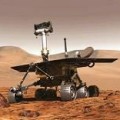It was January 3, 2004 when the exploration rover Spirit plunged through Mars' atmosphere in a protective balloon-like cocoon and bounced to a stop inside a crater. As an expectant team of scientists and engineers waited tensely at the Jet Propulsion Laboratory in California, mission controllers followed its trajectory.
Mission controller: "A signal indicates we are bouncing on the surface of Mars. This is a very good sign." Three weeks later, the rover Opportunity did the same on the other side of Mars.
The U.S. space agency NASA had thought that the planet's extremely frigid temperatures and dust storms would keep their lives short. But rover project scientist Albert Haldemann notes that they have far exceeded their planned lifetime.
"We expected some extended mission lifetime," he said. "We designed the warranty for these rovers for three months on Mars and we tested for nine months. So one might expect that we would have gotten nine months for free, and here we are at three years." The twin rovers' major findings came within the first 90 days. Opportunity found chemical evidence in bedrock that a shallow salt water sea existed at some time in Mars' past. Spirit drilled into volcanic rocks and found minerals suggesting they had been carried by water and collected in the lava's tiny pores as it hardened. The editor of the Internet website Marstoday.com, Keith Cowing, says those discoveries alone justified the mission.
"If they had both done that, or even if one of them had landed and still done that, it would have been considered a resounding success," said Keith Cowing. "But these amazing little robots are still going." Albert Haldemann says the inspection of the bedrock has been key to understanding Mars' evolution. He notes that the layers in bedrock are a geological history book.
"When you find rock that is attached to the planet, that then tells you about the history of that place," he said. "We have done that now in detail in two places on Mars. That tells us that Mars is a diverse place, that there are significant differences on these two sides of the planet where the rovers are, that Mars has complex geology, not unlike Earth in that sense." Since their early days, Spirit and Opportunity have roamed seven and 10 kilometers respectively past their original landing sites. Spirit is currently inspecting rocks and soils near a ridge while its twin is exploring a crater with exposed rock layers that tell a longer span of Martian history than those it examined before.
Haldemann attributes their longevity to careful ground control and good luck with Martian weather.
"Mars has been kind to these two rovers," he noted. "Both have had gusts of wind blow dust off of solar panels at different times during the mission, and each time that has happened, it has cleaned the solar panels and basically reset us as far as energy levels go, back to the beginning mission. That has been a new lease on life a couple of times for each rover." The rovers are going about their work reinvigorated with new navigation software uploaded into their computers. One of the technicians who guides the rovers, Scott Maxwell, says the improvements have made them smarter and more independent.
"They are now better than they used to be at finding their way through fields of obstacles," he said. "They can keep an eye on something as they are driving and make sure that they get close to that particular thing because it is an interesting science target. They have figured out how to watch the skies for clouds or watch the terrain for dust devils blowing by, and when they find those and they know those are interesting to us, to send back data on those. They have gotten smarter just as we have gotten smarter." The rovers have some mechanical wear and tear, but nothing serious enough to stop them. Albert Haldemann says they have just survived another Martian winter and believes that if dust storms do not block the sun's energy and cause the batteries to die, they could last another 18 months until the next Martian winter.

